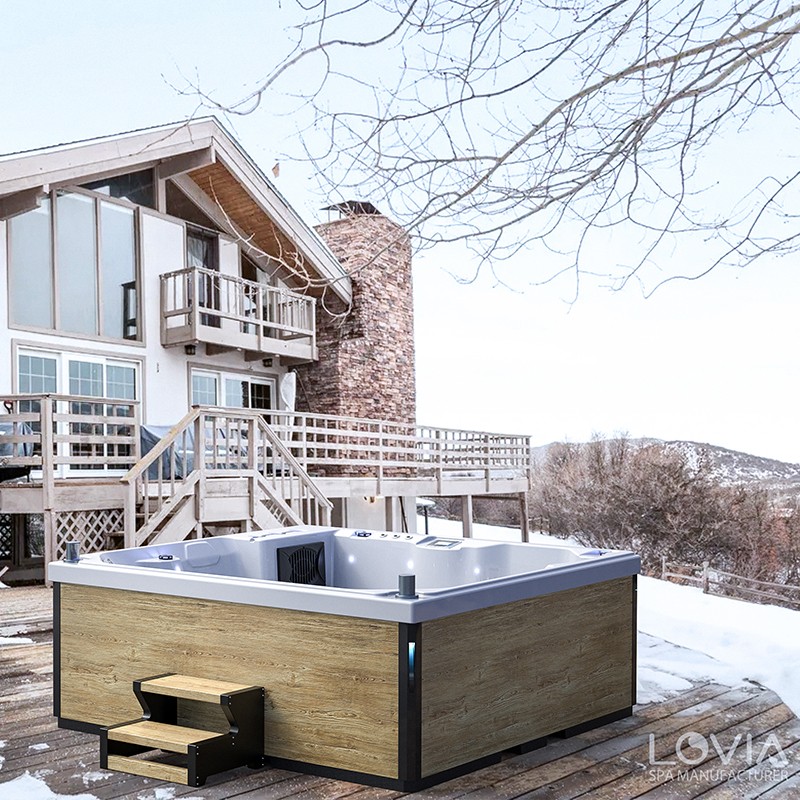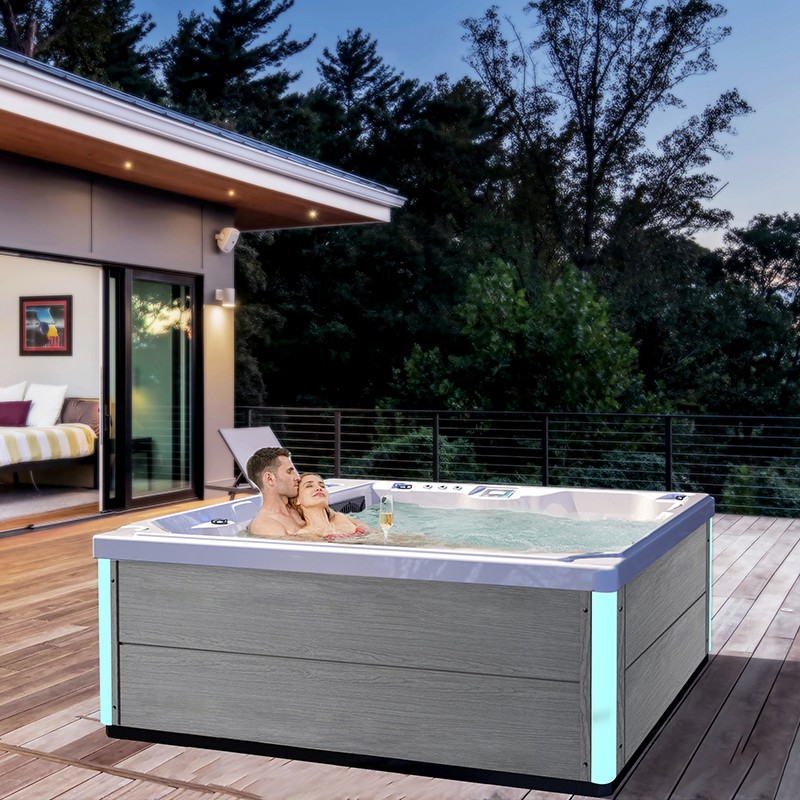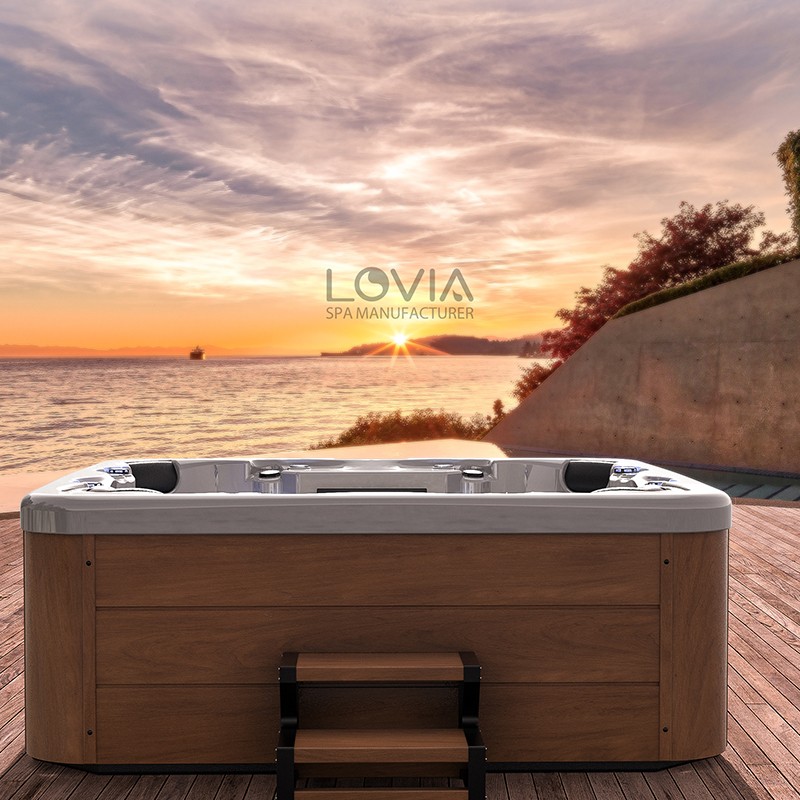
How often should bromine be added to an outdoor hot tub?
2024-11-14 15:30An outdoor hot tub is a facility that provides users with leisure, relaxation and hydrotherapy effects. Maintaining clean water quality is the key to ensuring the comfort and safety of the tub. Among all water quality management work, the use of disinfectants is the most important part. Bromine is an effective water disinfectant and is widely used in outdoor hot bathtubs. It can kill bacteria, fungi and algae in the water to ensure the cleanliness of the water.
However, the use of bromine is not a one-time addition, and it needs to be replenished regularly to maintain its effect. So, as a user, how often should we add bromine to an outdoor hot tub?

Why use bromine as a disinfectant for outdoor hot tubs?
When choosing a disinfectant for an outdoor hot bathtub, bromine and chlorine are the two most common choices. Although both have bactericidal effects, bromine has its unique advantages in many aspects, especially in high temperature environments.
High temperature stability of bromine:
The water temperature in an outdoor hot tub is usually high, usually between 37°C and 40°C, and chlorine will quickly decompose at high temperatures and lose its disinfection effect. In contrast, bromine is more chemically stable at high temperatures and can continue to exert its disinfection effect. This makes bromine a better choice for hot bathtubs, where it is effective at killing bacteria and other microorganisms at high temperatures.
Low irritation:
Bromine is less irritating to the skin and eyes than chlorine. Due to the higher water temperatures in outdoor hot tubs, the user's pores expand and the skin becomes more sensitive to chemicals. Therefore, using bromine can reduce skin, eye and respiratory discomfort and provide a more comfortable experience.
How bromine works:
Like chlorine, bromine combines with organic matter in the water to form bromine. However, bromine does not have the strong odor of chloramine, and bromine still has a certain bactericidal effect. This means that bromine can continue to disinfect even after combining with organic matter, while chloramine significantly reduces the disinfection ability of chlorine after it is formed.
It is precisely because of these advantages that bromine has become a common choice for outdoor hot bathtub disinfection. However, bromine is gradually consumed in the water over time, so it needs to be replenished regularly to maintain its effective concentration. So how often should bromine be added? The answer to this question depends on several factors.

What are the key factors that affect the frequency of bromine addition?
Frequency of use:
The frequency of use of a hot tub is one of the main factors that determine how often bromine should be added. If multiple people use a hot bathtub every day, contaminants such as body oils, sweat, and cosmetics will increase significantly in the water, which will accelerate the consumption of bromine. Frequent use means that bromine needs to be added more frequently to maintain its disinfecting effect. If the tub is used less frequently, the bromine consumption rate will be relatively slow, and the frequency of addition can be reduced.
Water temperature:
The water temperature in the hot tub is also a factor. Although bromine is more stable than chlorine at high temperatures, higher water temperatures will still accelerate its consumption. The higher the water temperature, the faster the bromine is consumed, so bromine needs to be added more frequently at high temperatures. It is generally recommended that the water temperature be in the range of 37°C to 40°C. If the temperature exceeds this range, bromine consumption may increase significantly.
Environmental conditions:
The outdoor environment will also affect bromine consumption. In hot tubs exposed to sunlight, the bromine in the water will break down due to the action of ultraviolet rays. Although bromine is not as sensitive to ultraviolet rays as chlorine, long periods of sun exposure will still reduce the effective concentration of bromine. If your hot tub is located in direct sunlight, you may need to add bromine more frequently to compensate for the decomposing effects of UV rays. In addition, external contaminants such as windblown sand, dust, and fallen leaves can also accelerate bromine consumption.
Initial water quality:
If the water in your hot tub is already relatively poor quality and contains a lot of impurities and contaminants, the bromine will react quickly with these contaminants, causing it to be consumed more quickly. Therefore, when initially treating the water, you may need to add a lot of bromine, and then do so less frequently for subsequent maintenance. Regular testing of the water to ensure that there are no excessive organic contaminants and microorganisms in the water can effectively slow down the consumption of bromine.
How do I know when to add bromine?
For bromine to be effective as a disinfectant, ideally, the bromine concentration in your outdoor hot tub should be between 3 and 5 ppm (parts per million). This concentration range ensures clean water and is less irritating to the skin and eyes. To accurately determine when bromine needs to be added, there are several methods that can be used:
Use a water quality test kit:
There are many convenient water quality test kits on the market that are specifically designed to measure the bromine concentration in water. These test kits usually include test strips or reagent packs that the user follows the instructions to dip into the water and then see the color change to determine the bromine concentration. If the bromine concentration is less than 3 ppm, it is a sign that bromine needs to be added to ensure the water is safe.
Monitor water quality regularly:
Regularly monitoring water quality is key to keeping the water clean, regardless of how often the hot bathtub is used. It is generally recommended to test the water at least once a week, especially if it is used frequently. If the water test results show that the bromine concentration is below the standard level, bromine should be added immediately. By regularly testing the water quality, you can prevent potential water quality problems and avoid the growth of bacteria caused by low bromine levels.
Observe water quality changes:
The appearance of the water quality is also a reference indicator to determine whether bromine needs to be added. If you notice that the water in your hot tub becomes cloudy, has an odor, or has sediment, these may be signs that the bromine level is insufficient. Although visual changes often mean that water quality problems have already occurred, observing the appearance of the water can be a hint to add bromine if testing is not possible immediately.

How to add bromine correctly?
Once you have determined that bromine needs to be added, you also need to understand how to do it correctly to ensure the effectiveness and safety of the disinfectant.
Use bromine tablets or powder:
Bromine is available in two common forms: tablets and powder. You can choose the appropriate form when using it. Bromine tablets are usually used in automatic dispensers or floating dispensers, which can slowly release bromine to maintain a stable bromine concentration in the water. Bromine powder needs to be added manually and can quickly increase the bromine concentration, but its effect lasts for a shorter period of time. Using bromine tablets can reduce the need for frequent additions, while bromine powder is suitable for quickly responding to a drop in bromine concentration.
Control the amount added:
When adding bromine, it is important to strictly follow the dosage recommendations in the product instructions to avoid overdosing or underdosing. Excessive bromine may cause skin and eye irritation and corrosive effects on equipment, while insufficient bromine cannot effectively kill bacteria. Therefore, regularly testing bromine concentrations and adding the appropriate amount of bromine based on the test results is the key to maintaining water quality balance.
Stir the water:
After adding bromine, it is recommended to turn on the bathtub's water pump system to allow the water to circulate and stir fully to ensure that the bromine is evenly distributed throughout the water. This can improve the effectiveness of the disinfectant and avoid localized concentrations that are too high or too low. Usually, turning on the pump for 15 to 30 minutes will achieve a good stirring effect.
Safety precautions:
When adding bromine, it is recommended to wear gloves and protective glasses to avoid direct contact with chemicals. Although bromine is relatively mild, it is still irritating, especially in powder form. Inhalation of bromine powder may cause respiratory discomfort. In addition, it is recommended to wait at least 30 minutes after adding bromine to ensure that the water quality is completely stable before entering the bathtub.

Bromine maintenance and other water quality management measures
In addition to regular addition of bromine, maintaining the water quality of outdoor hot bathtubs requires a combination of other management measures. For example, regular cleaning of filters, control of total alkalinity and pH in the water, etc., can help extend the shelf life of bromine and improve the overall water quality. Good water quality management can not only reduce bromine consumption, but also improve the user experience.
